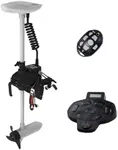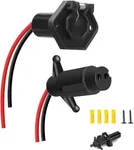Buying Guide for the Best Transom Mount Trolling Motors
Choosing the right transom-mount trolling motor can significantly enhance your boating experience. These motors are mounted on the stern (rear) of the boat and are used for precise control and maneuverability, especially in fishing scenarios. To make an informed decision, it's important to understand the key specifications and how they align with your specific needs and boating conditions.ThrustThrust is a measure of how powerful the trolling motor is, typically expressed in pounds (lbs). It is crucial because it determines how well the motor can move your boat through the water, especially in challenging conditions like strong currents or heavy winds. For small boats or kayaks, 30-40 lbs of thrust may be sufficient. Medium-sized boats might require 40-55 lbs, while larger boats may need 55 lbs or more. Consider the size and weight of your boat, as well as the typical water conditions you encounter, to choose the appropriate thrust level.
Shaft LengthThe shaft length is the distance from the motor head to the propeller and is important for ensuring the motor stays submerged at the correct depth. If the shaft is too short, the propeller may come out of the water, reducing efficiency and control. Conversely, a shaft that is too long can be cumbersome and may drag in shallow waters. For most boats, a shaft length of 30-42 inches is common. Measure the distance from the mounting point on the transom to the waterline and add 16-20 inches to determine the ideal shaft length for your boat.
VoltageVoltage indicates the power system of the trolling motor, typically 12V, 24V, or 36V. Higher voltage systems provide more power and longer run times but require more batteries. A 12V system is suitable for smaller boats and lighter use, while 24V and 36V systems are better for larger boats and more demanding conditions. Consider how long you plan to be on the water and the power needs of your boat to choose the right voltage. Ensure you have the appropriate battery setup to support the motor's voltage requirements.
Control TypeControl type refers to how you operate the trolling motor, with options including hand control, foot control, and remote control. Hand control is straightforward and easy to use, making it ideal for smaller boats. Foot control allows for hands-free operation, which is beneficial for fishing. Remote control offers the most flexibility, allowing you to control the motor from anywhere on the boat. Think about your typical boating activities and personal preferences to decide which control type will provide the best experience for you.
Mounting SystemThe mounting system is how the trolling motor attaches to the boat. A good mounting system should be sturdy and easy to install and remove. Some systems offer quick-release brackets, which are convenient if you need to frequently remove the motor. Ensure the mounting system is compatible with your boat's transom and that it provides a secure fit to prevent any movement or vibration during use. Consider how often you will need to mount and dismount the motor and choose a system that offers the right balance of security and convenience.
PropellerThe propeller is the part of the trolling motor that moves the boat through the water. The design and number of blades can affect performance. Three-blade propellers are common and provide a good balance of power and efficiency. Some propellers are designed to minimize weeds and debris, which can be beneficial in certain fishing environments. Consider the typical water conditions and any specific needs, such as weedless operation, to choose the right propeller for your trolling motor.















